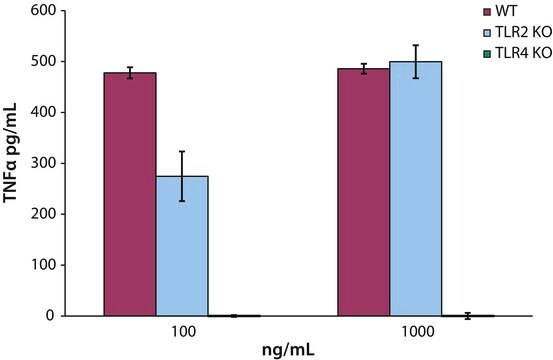L6893
Lipopolysaccharides (rough strains) from Escherichia coli F583 (Rd mutant)
Synonym(s):
LPS
Sign Into View Organizational & Contract Pricing
All Photos(2)
About This Item
Recommended Products
biological source
Escherichia coli (F583 Rd mutant)
Quality Level
form
lyophilized powder
impurities
<3% Protein (Lowry)
color
white to yellow cast
solubility
water: 4.90-5.10 mg/mL, cloudy to turbid, colorless to faintly yellow
shipped in
ambient
storage temp.
2-8°C
General description
This product is phenol:chloroform:petroleum ether extracted from E. coli F 583 (Rd mutant). The source strain is from a private collection.
Application
Lipopolysaccharides (LPSs) are characteristic components of the cell wall of Gram-negative bacteria. LPS and its lipid A moiety stimulate cells of the innate immune system by the Toll-like receptor 4 (TLR4), a member of the Toll-like receptor protein family, which recognizes common pathogen-associated molecular-patterns (PAMPs).
Biochem/physiol Actions
Lipopolysaccharides (LPS) are localized in the outer layer of the membrane and are, in noncapsulated strains, exposed on the cell surface. They contribute to the integrity of the outer membrane, and protect the cell against the action of bile salts and lipophilic antibiotics.
Preparation Note
Prepared by phenol-chloroform-petroleum ether extraction.
The product is soluble in water (5 mg/ml) or cell culture medium (1 mg/ml) yielding a hazy, faint yellow solution. A more concentrated, though still hazy, solution (20 mg/ml) has been achieved in aqueous saline after vortexing and warming to 70-80 oC. Lipopolysaccharides are molecules that form micelles in every solvent. Hazy solutions are observed in water and phosphate buffered saline. Organic solvents do not give clearer solutions. Methanol yields a turbid suspension with floaters, while water yields a homogeneously hazy solution.
The product is soluble in water (5 mg/ml) or cell culture medium (1 mg/ml) yielding a hazy, faint yellow solution. A more concentrated, though still hazy, solution (20 mg/ml) has been achieved in aqueous saline after vortexing and warming to 70-80 oC. Lipopolysaccharides are molecules that form micelles in every solvent. Hazy solutions are observed in water and phosphate buffered saline. Organic solvents do not give clearer solutions. Methanol yields a turbid suspension with floaters, while water yields a homogeneously hazy solution.
Other Notes
To gain a comprehensive understanding of our extensive range of Lipopolysaccharides for your research, we encourage you to visit our Carbohydrates Category page.
Signal Word
Danger
Hazard Statements
Precautionary Statements
Hazard Classifications
Acute Tox. 2 Oral
Storage Class Code
6.1A - Combustible acute toxic Cat. 1 and 2 / very toxic hazardous materials
WGK
WGK 3
Flash Point(F)
Not applicable
Flash Point(C)
Not applicable
Personal Protective Equipment
dust mask type N95 (US), Eyeshields, Gloves
Choose from one of the most recent versions:
Already Own This Product?
Find documentation for the products that you have recently purchased in the Document Library.
Customers Also Viewed
M Worku et al.
Journal of dairy science, 92(7), 3185-3193 (2009-06-17)
The objective of this study was to evaluate the effect of smooth (S) and rough (R) forms of lipopolysaccharide (LPS) on gene expression in bovine blood neutrophils. Isolated neutrophils (10(7) cells/mL) were treated with Escherichia coli LPS serotype O111:B4 (S+R)
Yawen Ni et al.
PloS one, 12(2), e0170346-e0170346 (2017-02-09)
Occludin is a key tight junction (TJ) protein in cerebral endothelial cells (CECs) playing an important role in modulating blood-brain barrier (BBB) functions. This protein (65kDa) has been shown to engage in many signaling pathways and phosphorylation by both tyrosine
Iga Kucharska et al.
Biochemistry, 55(36), 5061-5072 (2016-08-18)
Pseudomonas aeruginosa is an opportunistic human pathogen causing pneumonias that are particularly severe in cystic fibrosis and immunocompromised patients. The outer membrane (OM) of P. aeruginosa is much less permeable to nutrients and other chemical compounds than that of Escherichia
G Werner-Felmayer et al.
Clinical and diagnostic laboratory immunology, 2(3), 307-313 (1995-05-01)
In a number of mammalian cell types, pteridine biosynthesis from guanosine 5'-triphosphate and formation of nitric oxide from L-arginine are induced by gamma interferon (IFN-gamma) and bacterial lipopolysaccharide (LPS). We assessed the possibility of using such metabolic alterations for the
Our team of scientists has experience in all areas of research including Life Science, Material Science, Chemical Synthesis, Chromatography, Analytical and many others.
Contact Technical Service



